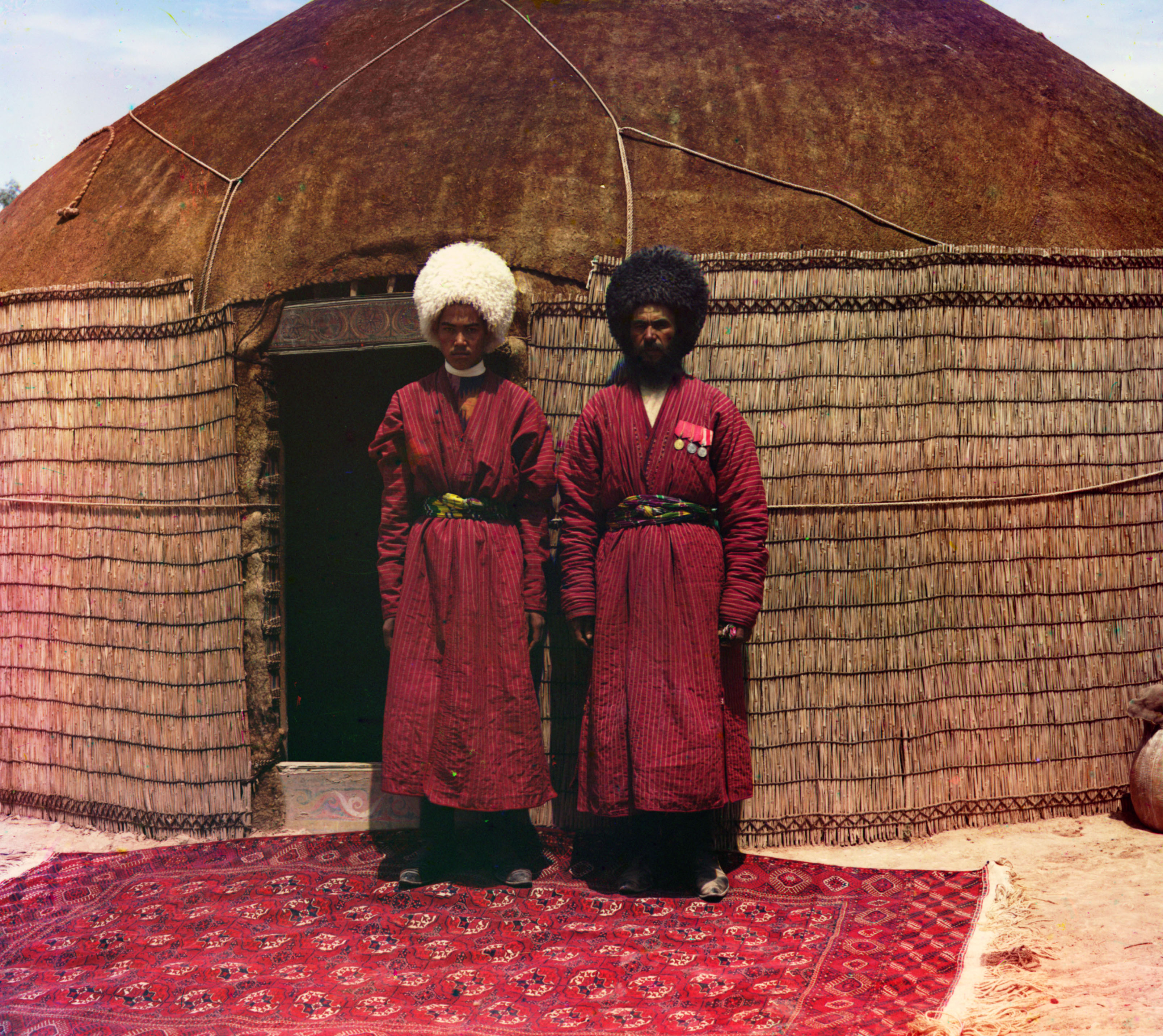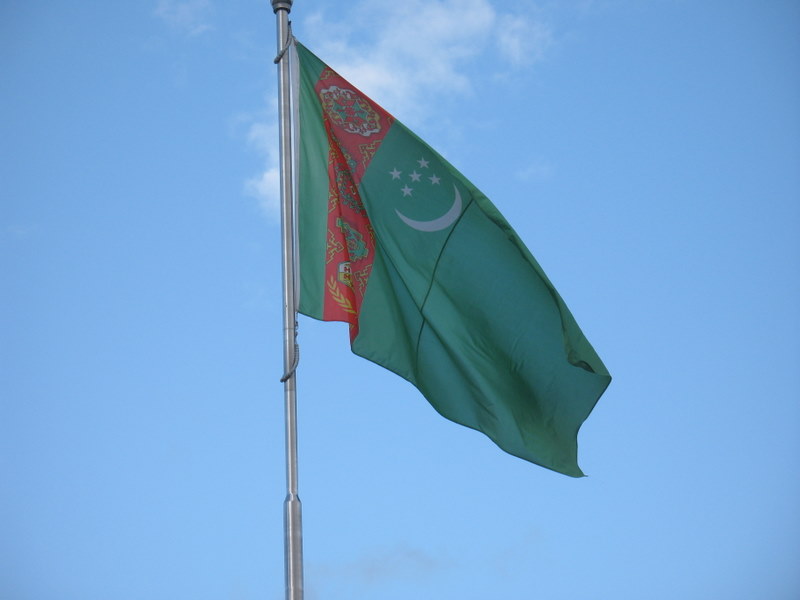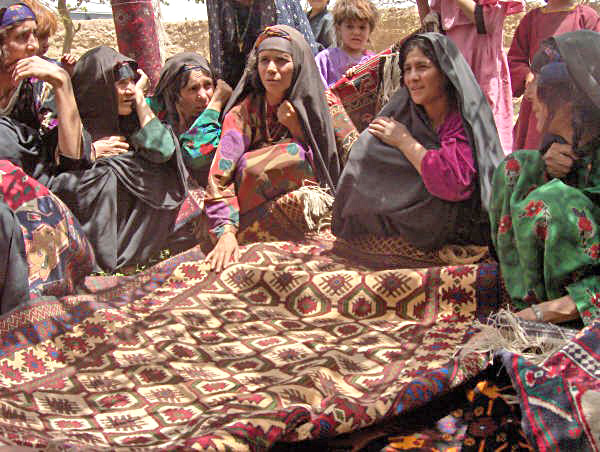|
Turkmen Carpet
A Turkmen rug ( tk, Türkmen haly; or Turkmen carpet or Turkoman carpet) is a type of handmade floor-covering textile traditionally originating in Central Asia. It is useful to distinguish between the original Turkmen tribal rugs and the rugs produced in large numbers for export mainly in Pakistan and Iran today. The original Turkmen rugs were produced by the Turkmen tribes who are the main ethnic group in Turkmenistan and are also found in Afghanistan and Iran. They are used for various purposes, including tent rugs, door hangings and bags of various sizes. Traditional turkmen carpet making art has been inscribed on the Representative list of the Intangible Cultural Heritage of Humanity by the Intergovernmental Committee for the Safeguarding of Intangible Cultural Heritage of UNESCO in 2019. History A few centuries back, almost all Turkmen rugs were produced by nomadic tribes almost entirely with locally obtained materials, wool from the herds and vegetable dyes, or oth ... [...More Info...] [...Related Items...] OR: [Wikipedia] [Google] [Baidu] |
Saryk
The Saryk () are a tribe of Turkmens in Turkmenistan. The Saryk mostly live in the valley of the Marghab River (the ancient Margiana). Etymology Suggestions for the etymology of ''Saryk'' (also ''Sarik, Saryq'') are the Middle Turkic ''saryγ'' ("yellow") or the Kipchak root ''saryq'' ("sheep"). History In the early 19th century the Saryk lived in the Merv region, but from 1830 they were driven further up the Marghab valley by the Teke. Bala Murghab and the Panjdeh became their main settlements. In 1881, the Saryk came under Russian control after the Battle of Geok Tepe and the creation of the Transcaspian Oblast. In 1885, the Saryk population was estimated at 65,000. They continued under Russian rule through the Soviet period. Today most live in modern Turkmenistan, with some living over the borders in Iran and Afghanistan. Art and culture Like other Turkmen tribes, the Saryk are known as carpet-makers and have their own distinctive style: dark red-brown carpets with the ... [...More Info...] [...Related Items...] OR: [Wikipedia] [Google] [Baidu] |
Tradition
A tradition is a belief or behavior (folk custom) passed down within a group or society with symbolic meaning or special significance with origins in the past. A component of cultural expressions and folklore, common examples include holidays or impractical but socially meaningful clothes (like lawyers' wigs or military officers' spurs), but the idea has also been applied to social norms such as greetings. Traditions can persist and evolve for thousands of years—the word ''tradition'' itself derives from the Latin ''tradere'' literally meaning to transmit, to hand over, to give for safekeeping. While it is commonly assumed that traditions have an ancient history, many traditions have been invented on purpose, whether that be political or cultural, over short periods of time. Various academic disciplines also use the word in a variety of ways. The phrase "according to tradition", or "by tradition", usually means that whatever information follows is known only by oral tradition, ... [...More Info...] [...Related Items...] OR: [Wikipedia] [Google] [Baidu] |
Tribe
The term tribe is used in many different contexts to refer to a category of human social group. The predominant worldwide usage of the term in English language, English is in the discipline of anthropology. This definition is contested, in part due to conflicting theoretical understandings of social and kinship structures, and also reflecting the problematic application of this concept to extremely diverse human societies. The concept is often contrasted by anthropologists with other social and kinship groups, being hierarchically larger than a lineage or clan, but smaller than a chiefdom, nation or state (polity), state. These terms are equally disputed. In some cases tribes have legal recognition and some degree of political autonomy from national or federal government, but this legalistic usage of the term may conflict with anthropological definitions. In the United States, Tribe (Native American), Native American tribes are legally considered to have "domestic dependent ... [...More Info...] [...Related Items...] OR: [Wikipedia] [Google] [Baidu] |
Emblem Of Turkmenistan
An emblem is an abstract or representational pictorial image that represents a concept, like a moral truth, or an allegory, or a person, like a king or saint. Emblems vs. symbols Although the words ''emblem'' and '' symbol'' are often used interchangeably, an emblem is a pattern that is used to represent an idea or an individual. An emblem develops in concrete, visual terms some abstraction: a deity, a tribe or nation, or a virtue or vice. An emblem may be worn or otherwise used as an identifying badge or patch. For example, in America, police officers' badges refer to their personal metal emblem whereas their woven emblems on uniforms identify members of a particular unit. A real or metal cockle shell, the emblem of St. James the Apostle, sewn onto the hat or clothes, identified a medieval pilgrim to his shrine at Santiago de Compostela. In the Middle Ages, many saints were given emblems, which served to identify them in paintings and other images: St. Cather ... [...More Info...] [...Related Items...] OR: [Wikipedia] [Google] [Baidu] |
Flag Of Turkmenistan
The flag of Turkmenistan ( tk, Türkmenistanyň baýdagy) features a white crescent (symbol of Islam) and five stars representing the five regions of the country and the Five Pillars of Islam. Placed upon a green field is a symbolic representation of the country's famous carpet industry. It was introduced as the flag of Turkmenistan on 27 September 1992 to replace the Soviet-era flag which consisted of a red background with two light blue bars in the middle. The modified version with a 2:3 ratio was adopted on 23 January 2001. State Flag and Constitution Day is celebrated on 18 May. Description It features a green field with a vertical red stripe near the hoist side, containing five carpet guls (designs used in producing rugs) stacked above two crossed olive branches similar to those on the flag of the United Nations; a white waxing crescent moon, typical of Turkic and Islamic symbology, and five white five-pointed stars appear in the upper corner of the field just to the fl ... [...More Info...] [...Related Items...] OR: [Wikipedia] [Google] [Baidu] |
Guinness Book Of Records
''Guinness World Records'', known from its inception in 1955 until 1999 as ''The Guinness Book of Records'' and in previous United States editions as ''The Guinness Book of World Records'', is a reference book published annually, listing world records both of human achievements and the extremes of the natural world. The brainchild of Sir Hugh Beaver, the book was co-founded by twin brothers Norris and Ross McWhirter in Fleet Street, London, in August 1955. The first edition topped the best-seller list in the United Kingdom by Christmas 1955. The following year the book was launched internationally, and as of the 2022 edition, it is now in its 67th year of publication, published in 100 countries and 23 languages, and maintains over 53,000 records in its database. The international franchise has extended beyond print to include television series and museums. The popularity of the franchise has resulted in ''Guinness World Records'' becoming the primary international authority ... [...More Info...] [...Related Items...] OR: [Wikipedia] [Google] [Baidu] |
The Largest Carpet In The World
''The'' () is a grammatical article in English, denoting persons or things already mentioned, under discussion, implied or otherwise presumed familiar to listeners, readers, or speakers. It is the definite article in English. ''The'' is the most frequently used word in the English language; studies and analyses of texts have found it to account for seven percent of all printed English-language words. It is derived from gendered articles in Old English which combined in Middle English and now has a single form used with pronouns of any gender. The word can be used with both singular and plural nouns, and with a noun that starts with any letter. This is different from many other languages, which have different forms of the definite article for different genders or numbers. Pronunciation In most dialects, "the" is pronounced as (with the voiced dental fricative followed by a schwa) when followed by a consonant sound, and as (homophone of pronoun ''thee'') when followed by a v ... [...More Info...] [...Related Items...] OR: [Wikipedia] [Google] [Baidu] |
Afghan Rug
An Afghan rug (or Afghan carpet) is a type of handwoven floor-covering textile traditionally made in the northern and western areas of Afghanistan, mainly by Afghan Turkmens and Uzbeks. Types and varieties One of the most exotic and distinctive of all oriental rugs is the '' Shindand'' or '' Adraskan'' (named after local Afghan towns), woven in the Herat Province, in western Afghanistan. Strangely elongated human and animal figures are their signature look. The carpet can be sold across Afghanistan with the most based in Mazar-e Sharif. Another staple of Afghanistan is Baluchi rugs, most notably Baluchi prayer rugs. They are made by Afghanistan's Baloch people in the south-western part of the country. Various vegetable and other natural dyes are used to produce the rich colors. The rugs are mostly of medium sizes. Many patterns and colors are used, but the traditional and most typical is that of the octagonal elephant's foot (Bukhara) print, often with a red background. T ... [...More Info...] [...Related Items...] OR: [Wikipedia] [Google] [Baidu] |
Ashgabat
Ashgabat or Asgabat ( tk, Aşgabat, ; fa, عشقآباد, translit='Ešqābād, formerly named Poltoratsk ( rus, Полтора́цк, p=pəltɐˈratsk) between 1919 and 1927), is the capital and the largest city of Turkmenistan. It lies between the Karakum Desert and the Kopetdag mountain range in Central Asia, near the Iran-Turkmenistan border. The city was founded in 1881 on the basis of an Ahal Teke tribal village, and made the capital of the Turkmen Soviet Socialist Republic in 1924. Much of the city was destroyed by the 1948 Ashgabat earthquake, but has since been extensively rebuilt under the rule of Saparmurat Niyazov's "White City" urban renewal project, resulting in monumental projects sheathed in costly white marble. The Soviet-era Karakum Canal runs through the city, carrying waters from the Amu Darya from east to west. Since 2019, the city has been recognized as having one of the highest costs of living in the world largely due to Turkmenistan's inflation ... [...More Info...] [...Related Items...] OR: [Wikipedia] [Google] [Baidu] |
Turkmen Carpet Museum
The Turkmen Carpet Museum or the National Carpet Museum is a national museum, situated on 5 Gorogly Street in Ashgabat, Turkmenistan. The museum opened on 24 October 1994. It has the largest collection of Turkmen carpets of any museum. It has a rich collection of Turkmen carpets from the medieval through to the 20th century, including over 1000 carpets from the 18th and 19th centuries. Aside from its extensive collection of antique carpets, it has many carpet articles, chuvals, khurjuns, torba etc. On the first floor of the museum are Tekke and Sarik carpets. The museum is noted for its huge Tekke carpets. One Tekke carpet measures 193m² and weighs a tonne and was made by some 40 people in 1941 to make a curtain for the Bolshoi Theatre in Moscow. Another, made in 2001, is even larger, measuring 301m² and 14 by 21.2 metres and was made to commemorate 10 years of Turkmen independence from the Soviet Union. It is recognised by the Guinness World Records as the largest hand-woven ... [...More Info...] [...Related Items...] OR: [Wikipedia] [Google] [Baidu] |
Octagon
In geometry, an octagon (from the Greek ὀκτάγωνον ''oktágōnon'', "eight angles") is an eight-sided polygon or 8-gon. A '' regular octagon'' has Schläfli symbol and can also be constructed as a quasiregular truncated square, t, which alternates two types of edges. A truncated octagon, t is a hexadecagon, . A 3D analog of the octagon can be the rhombicuboctahedron with the triangular faces on it like the replaced edges, if one considers the octagon to be a truncated square. Properties of the general octagon The sum of all the internal angles of any octagon is 1080°. As with all polygons, the external angles total 360°. If squares are constructed all internally or all externally on the sides of an octagon, then the midpoints of the segments connecting the centers of opposite squares form a quadrilateral that is both equidiagonal and orthodiagonal (that is, whose diagonals are equal in length and at right angles to each other).Dao Thanh Oai (2015), "Equilatera ... [...More Info...] [...Related Items...] OR: [Wikipedia] [Google] [Baidu] |



.jpg)

.jpg)
.png)
